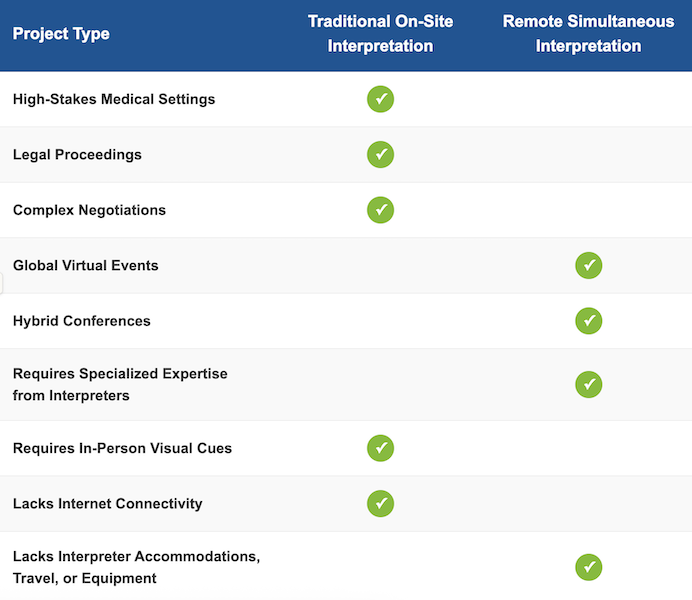Whether you’re hosting a multilingual conference, organizing a virtual event, conducting international business meetings, or providing essential services to multilingual communities, professional interpretation can help break down language barriers. There are several options available, with two of the most prominent being Remote Simultaneous Interpretation (RSI) and traditional interpreting. We’ll explain the differences between them, their benefits, and how to get started.
What Is Traditional Interpretation?
Traditional interpretation involves interpreters who are physically present and interpreting in real time. This is the type of interpretation most people are familiar with already.
In some cases, the interpreter will perform consecutive interpreting, meaning that they provide their interpretation during the natural pauses in the speaker’s speech. This allows the audience to listen to the speaker’s inflection while also giving the interpreter more time to understand what’s being said and interpret it accurately.
In other cases, the interpreter will use simultaneous interpretation, meaning that they provide their interpretation as quickly as possible following the speaker’s speech—usually lagging only a few seconds behind them. This allows the speaker to talk faster and keep the conversation moving.
The Benefits of Traditional Interpreting
The top benefits of traditional interpreting include:
- Personal connection with audience members
- Non-verbal cues and communication
- Lack of technological requirements
- Added context and nuance
- More control over room acoustics and background noise
What Is Remote Simultaneous Interpretation (RSI)?
Remote Simultaneous Interpretation involves interpreters who join an event remotely and interpret in real time through technology. This type of interpretation has become more popular as technology has advanced to support it as an efficient, cost-effective option.
While traditional interpretation requires an interpreter to appear in person, RSI allows interpreters to work from anywhere, as long as the proper technology is in place. These interpreters require specialized digital platforms made to facilitate their work, often including:
- High-quality audio transmission
- Dedicated audio channels for different languages
- Interpreter handoff capabilities
- Robust backup systems
Audience members typically listen to these interpretations through headphones, mobile apps, websites, or digital platforms.
The Benefits of Remote Simultaneous Interpretation
The top benefits of Remote Simultaneous Interpreting include:
- Eliminating travel and accommodation costs
- Access to specialized interpreters around the world
- Faster implementation
- Easier to scale up or down as needed
- More accessible to a global audience
Choosing the Right Interpretation Service
Certain events or projects tend to benefit from traditional interpretation, while others are better suited to take advantage of Remote Simultaneous Interpretation. A few common scenarios are laid out below to give you an idea of which interpretation service may be best for you.

Still not sure? Our professionals can help you decide which service is right for you.
Experience Excellence in Interpretation with TNOLA Languages
At TNOLA Languages, we’re committed to breaking down language barriers with both time-tested methods and innovative solutions. Our interpretation services combine human expertise with appropriate technology to deliver interpretation excellence tailored to your specific needs.
Bring High-Quality Interpretation to Your Event
Partner with TNOLA Languages to create communities through communication. Contact us today for a free quote and experience the difference professional interpretation services can make.
